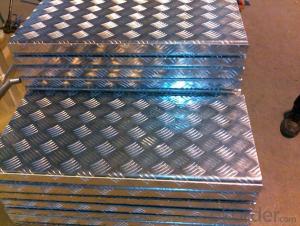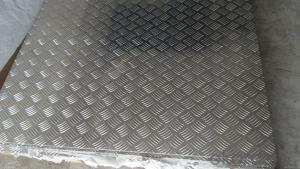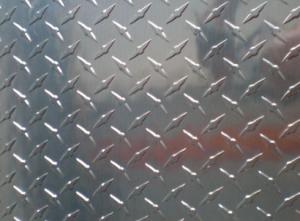Perforated Aluminum Checkered Sheet AA1100 for Automotive Body
- Loading Port:
- Shanghai
- Payment Terms:
- TT OR LC
- Min Order Qty:
- 5 m.t.
- Supply Capability:
- 10000 m.t./month
OKorder Service Pledge
OKorder Financial Service
You Might Also Like
Specification
1. Specification of Five Bar Checkered Aluminum Sheet AA1100 for Automotive Body
ALLOY | AA1050 AA1060 AA1070 AA1100 ETC AA3003 AA3004 AA3005 AA3104 AA3105 ETC AA5005 AA5052 AA5083 AA5754 ETC AA8011 AA8006 AA8079 ETC |
TEMPER | H14,H16,H18,H22,H24,H26,H32,O/F |
THICKNESS | ≥0.2MM |
WIDTH | 30mm-2100mm |
COIL WGT | 2Mt - 3Mt |
COIL ID | φ508mm,φ610mm |
SURFACE | PE Protecting film |
STANDARD | GB/T 3880-2006 |
2. Application of Five Bar Checkered Aluminum Sheet AA1100 for Automotive Body
(1).Interior: wall cladding, ceilings, bathrooms, kitchens and balconies, shutters, doors...
(2).Exterior: wall cladding, facades, roofing, canopies, tunnels,column covers , renovations...
(3).Advertisement: display platforms, signboards, fascia, shop fronts...
3. Feature of Five Bar Checkered Aluminum Sheet AA1100 for Automotive Body
Surfact Quality :
Be free from Oil Stain, Dent, Inclusion, Scratches, Stain, Oxide Dicoloration, Breaks, Corrosion, Roll Marks, Dirt Streaks and other defect which will interfere with use,
Mechenical Property:
Chemical Composite and Mechanical Property
4. Certificate:
SGS and ROHS(if client request, paid by client), MTC(plant provided), Certificate of Origin(FORM A, FORM E, CO), Bureau Veritas and SGS (if client request, paid by client), CIQS certificate
5. Image of Five Bar Checkered Aluminum Sheet AA1100 for Automotive Body



6. Package and shipping of Five Bar Checkered Aluminum Sheet AA1100 for Automotive Body
First, plastic cloth with drying agent inside; Second, Pearl Wool ; Third, wooden cases with dry agent , fumigation wooden pallets, aluminum surface could cover blue PVC film
7. FAQ
1) What is the delivery time?
Dpends on actual order, around 20 to 35 days
2)What is the QC system:
We have QC staff of 20 persons and advanced equipment, each production is with MTC traced from Aluminum ingot lot.
3) What market do you mainly sell to?
Australia, America, Asia, Middle East, Western Europe, Africa etc
- Q: What are the different types of surface treatments available for anodized aluminum sheets?
- There are several types of surface treatments available for anodized aluminum sheets, including polishing, brushing, sandblasting, etching, and coloring. Each treatment option provides a unique aesthetic and functional finish to the aluminum surface.
- Q: Can aluminum sheet be used for electrical grounding applications?
- Yes, aluminum sheet can be used for electrical grounding applications. Aluminum is a highly conductive material, making it suitable for use in grounding systems. It is often used in various electrical applications due to its low resistance and excellent electrical conductivity. Aluminum sheet can effectively carry electrical current and safely dissipate it into the ground, ensuring the protection of electrical systems and preventing electrical hazards. Additionally, aluminum's lightweight and corrosion-resistant properties make it a preferred choice for grounding applications in various industries, including construction, automotive, and aerospace.
- Q: What are aluminum sheets used for?
- Due to their unique properties and versatility, aluminum sheets find a wide range of uses. In the construction industry, they are commonly employed for roofing, siding, and cladding, thanks to their lightweight nature, corrosion resistance, and durability. These qualities make them ideal for such purposes. In the transportation industry, aluminum sheets are widely utilized in the manufacturing of automobiles, trains, and aircraft due to their high strength-to-weight ratio. They also serve as a lightweight yet sturdy solution for trailers, truck bodies, and shipping containers. Another significant application of aluminum sheets lies in the manufacturing of consumer products. They are used to make household appliances, cookware, and electronics, as they possess excellent thermal conductivity and resistance to rust and corrosion. Additionally, their ability to withstand various weather conditions makes them suitable for the production of signage, billboards, and displays. In the packaging industry, aluminum sheets play a crucial role in the production of cans, foils, and lids. Their impermeability to light, moisture, and oxygen helps preserve the freshness and quality of food and beverages. Moreover, aluminum sheets have various industrial applications. They are utilized in the fabrication of industrial machinery, equipment, and tools due to their excellent machinability and strength. Additionally, their thermal and electrical conductivity makes them suitable for the production of heat exchangers, solar panels, and electrical conductors. In summary, aluminum sheets find application in construction, transportation, consumer products, packaging, and various industrial sectors, owing to their lightweight, corrosion resistance, durability, thermal conductivity, and electrical conductivity.
- Q: I'm working on this project and I have to glue together a 4mm thick aluminum and a 5mm aluminum. It's a 17mm wide hexagon.
- Aluminum does not glue very easily. Welding is better, but if it's not for something structural any kind of Crazy Glue or Super Glue will hold it in position. It won't hold together under any kind of stress though. Alternately you could use machine screws, or self tapping screws.
- Q: Trying to find the best aluminum powder I can buy for rocket engines and pyrotechnic (fireworks) uses?
- For okorder (I think there prices are the same as the other high end brands, except Star Molecule is not diluted, and it works better from my experience).
- Q: who knows the ceiling technology of aluminum sheet?
- Construction technology of ceiling aluminum sheet: (1) firstly check keel’s quality, the straight shape and uniformly forced state of boom, control the keel’s gap within 500mm, reduce the gap according to design requirement under humid environment. The lower surface of keel is smooth without a sense of bearing down, main device is closely connected with accessories, it can be bound after being confirmed qualified.(2) we should break the board along the cutting line and ensure the margin of cutting board straight and square without any chipping or arris defect. (3) while placing and fixing the board, we can place edge of aluminum-plastic panel(encapsulated edge) in the vertical direction of supporting keel, there is a phenomena of hanging. Aluminum-plastic panel should be placed closely in the process of butt joint, it can’t be pressed. You can start from a plate angle or middle position, and don’t place them at the same time. Slab joint should be straight and in the same width, without break joint. (4) in the process of joint, Aluminum-plastic panel should be placed closely in the process of butt joint, it can’t be pressed. And the butt joint should be stagger, the butt joint can’t be connected on the same keel. When you use doubling plate, the joints of the second layer board and the first layer board can’t be connected with the same keel, double-deck gypsum board should be staggered joints.
- Q: This question asks about the various surface treatments or finishes that can be applied to custom-made aluminum sheets.
- <p>Custom-made aluminum sheets can be finished in a variety of ways to achieve different aesthetic and functional properties. Some of the common finishes include: Anodizing, which provides a protective oxide layer and can be colored; Powder coating, offering a durable and colorful finish; Mill finish, which is the natural surface of the aluminum after rolling; Brushed or Satin finish, giving a鍝戝厜 texture; Mirror finish, providing a reflective, polished surface; and Painted finish, where the aluminum is coated with a layer of paint for color and protection. Each finish serves different purposes, from enhancing corrosion resistance to improving the visual appeal of the aluminum sheet.</p>
- Q: Can aluminum plate protect against radiation?
- Two. A brief introduction to radiation:Radiation refers to electromagnetic energy from the source part from the field source and transmitted, then return to the source, energy by electromagnetic waves or particles (such as the Alfa particle, beta particle) in the form of outward diffusion. All objects in nature, as long as the temperature is above zero degrees of absolute temperature, send the heat continuously in the form of electromagnetic waves and particles. This way of transmitting energy is called radiation. The radiation energy radiates straight from the source outward in all directions. The energy emitted by an object through radiation is called radiant energy. The radiation was calculated by roentgen / hour (R). One important feature of radiation is that it is "peer"". A body can radiate radiation to a second object, and at the same time a radiation to a target, regardless of the temperature of the object (gas). The term is commonly used in ionizing radiation. Radiation itself is a neutral term, but radiation from certain substances can be harmful.
- Q: How do aluminum sheets perform in terms of machinability?
- Known for their excellent machinability, aluminum sheets can easily be cut, drilled, and shaped using various machining processes such as milling, turning, and drilling. Compared to materials like steel, aluminum has a low melting point and is relatively soft, making it more manageable to work with. Additionally, aluminum sheets offer good chip control, resulting in smaller and more manageable chips during machining. This not only reduces the risk of tool breakage but also improves the overall efficiency of the machining process. Furthermore, aluminum sheets possess exceptional thermal conductivity, effectively dissipating heat generated during machining. As a result, tool wear is minimized, and the life of the tool is prolonged. With their ease of machining and versatility, aluminum sheets find wide applications across various industries.
- Q: So I want to solder aluminum cans together for this project I have. What tools will I need?
- Your aluminum can's are unfortunatly too thin to solder. Your best bet for this project, is going to be a hot glue gun. Hope this helps.
Send your message to us
Perforated Aluminum Checkered Sheet AA1100 for Automotive Body
- Loading Port:
- Shanghai
- Payment Terms:
- TT OR LC
- Min Order Qty:
- 5 m.t.
- Supply Capability:
- 10000 m.t./month
OKorder Service Pledge
OKorder Financial Service
Similar products
Hot products
Hot Searches
Related keywords


























